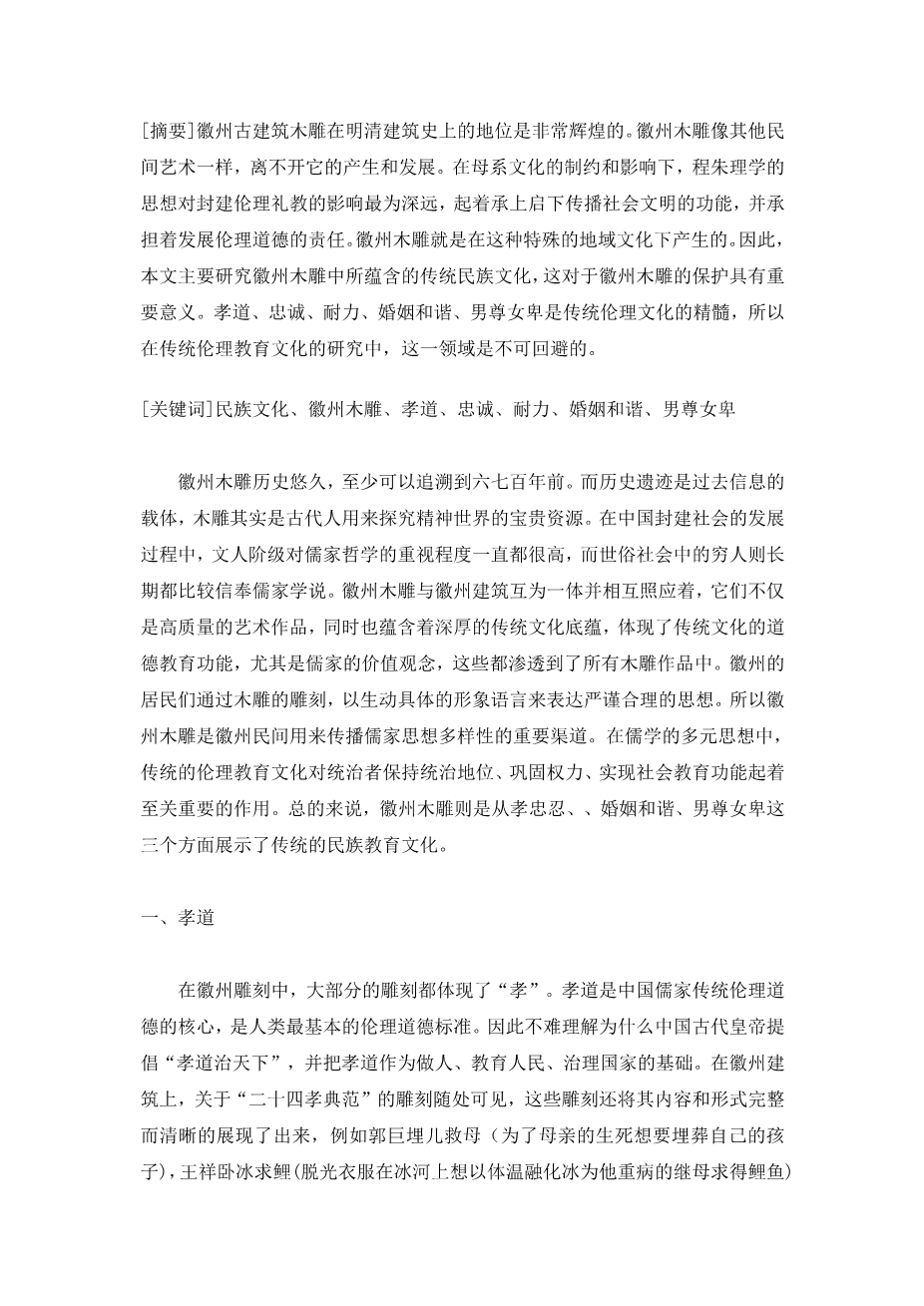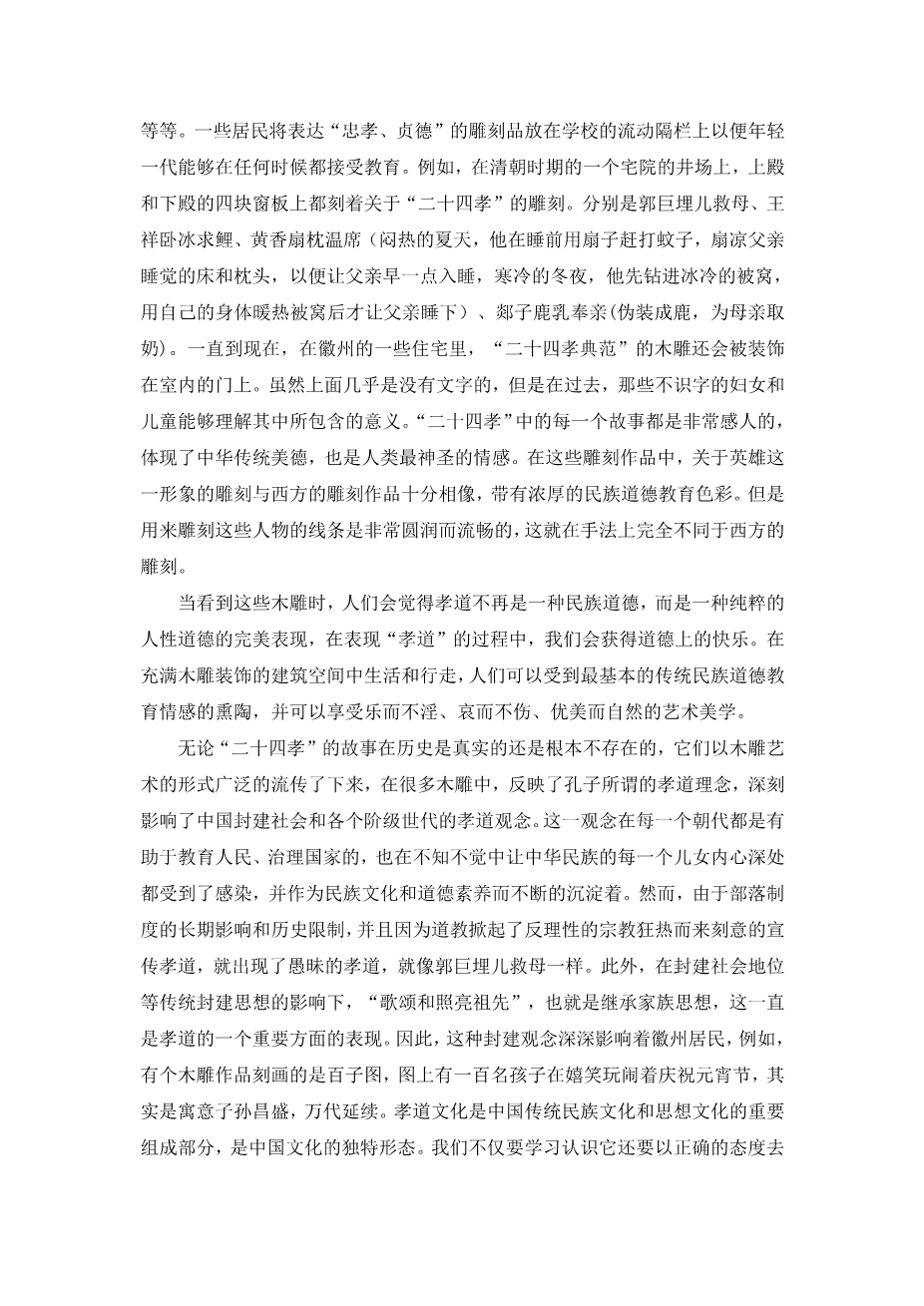[Abstract] Huizhou wood carving on ancient buildings has been brilliant in the architectural history of Ming and Qing Dynasty. Huizhou wood carving like other folk arts can not generate and develop without the restriction and influence of the mother culture, among which CHENG and ZHUrsquo;s Neo-Confucianism has made the most far-reaching influence that advocates feudal ethics and rites, shoulders the function of social civilizing and takes the responsibility to develop ethics and morals. Huizhou wood carving generates under this special regional culture. Therefore, the interpretation and research on traditional ethic culture contained in Huizhou wood carving is of critical significance to the protection of Huizhou wood carving. Filial piety, loyalty, great endurance, marriage harmony, male superiority and female subjugation are the essence of traditional ethic culture, and this field should not be avoided in the research of traditional ethic educational culture.
[Key words] Ethic culture, Huizhou wooden carving, Filial piety, Loyalty, Great endurance, Marriage harmony, Male superiority and female subjugation.
Huizhou wood carving has a long history and can be dated back to six and seven hundreds years ago at least. Historical material remains are carriers of the information in the past. Wood carvings are precious resources for the prying of the spiritual world of ancient people. During the development of Chinese feudal society, the literati -official class had paid attention to Confucian philosophy all long, and poor people in the secular society tended to believe in Confucian theory. Huizhou wood carvings and Huizhou buildings have set off each other. They are not only high-quality artistic works, but also deep traditional cultural deposit, expressing traditional culture and moral education func-tion, particularly Confucian value concept, all of which have permeated in all wood carving works. Ancestors in Huizhou have expressed their rigorous and reasonable thought with vivid and specific image language through wood carvings. Huizhou wood carving is actually an important channel for diversified thoughts of Confucianism transmitting among the folk society in Huizhou. Among diversified thoughts of Confucianism, traditional ethical education culture plays a vital role in rulers preserving their dominance and consolidating their power, and realizing social education function. Huizou wood carving has demonstrated traditional ethnical education culture from three aspects, which are filial piety, loyalty and great endurance, and marriage harmony and male superiority and female subjugation.
I. Filial piety
Among Huizhou carvings, most have manifested “filial piety”. Filial piety is the core of Chinese Confucian traditional ethnics and morals, and the most basic ethical and moral standard to be a man. Hence, it is not difficult to understand that Chinese emperors have advocated “governing the world by filial piety politics” and treated filial piety as the base to behave oneself, educate people, and govern the country. On Huizhou buildings, “the twenty-four filial exemplars” are commonly seen, and the contents and forms have been reflected completely and clearly, such as Guoju Maier (GUO Ju buried his child for the benefit of his mother), Wobing Qiuli (groveling nakedly on the ice for carps his stepmother fond of), and so on. Some residents have put the carving of “loyalty, filial piety, chastity and righteousness” on the fence board on the partition door of the ambulatory (Fig.1), so that the younger generation can receive education at any time. For example, in the well yard of a residence of Qing Dynasty, four stories from “the twenty-four filial exemplars” have been carved on four window boards of the upper and bottom hall, which are Guoju Maier, Wobing Qiuli, Shanzhen Wenqi (fanning in summer and warming in winter for father), Luru Fengqin (disguising as a deer to get the its milk for mother). Still, on some Huizhou residences, wood carvings of “the twenty-four filial exemplars” have been decorated on interior doors. Though few words have been carved, those illiterate women and children in the past could understand implications contained in them. Every story of “the twenty-four filial exemplars” is moving, reflecting traditional virtues and also the most holy emotion of human. In these carving works, the heroes are just like disciples in the west, touched with heavy ethnic and moral education color. But wood carving lines of these figures are mellow and smooth, totally different from sculptures of western disciples.
When seeing these wood carvings, people will feel that filial piety is no longer the ethnic and moral regularity, but a presentation of pure humanity and perfect manifestation of morals, and that it can gain a kind of moral pleasure when implementing filial piety. When living and walking in the architectural space full of wood carving decorations, people can be influenced by the most essential traditional ethnic morals and education, and enjoy the pleasant but not obscene, mournful but not distressing, graceful and natural artistic aesthetics.
No matter the stories of “the twenty-four filial exemplars” are true or not in the history, they have widely spread in the artistic form of wood carvings, and reflected Confucius filial piety, deeply influencing the filial concept of generations of feudal society and all classes in China. This concept has helped to educate people and govern the country in each dynasty, and unconsciously affected the deep heart of each member of Chinese nation, and constantly accumulated as the general national culture and moral psychology. However, due to the long-term influence of tribal system and historical limits, and as Taoists have intently publicized filial piety by aid of anti-rational religious madness, the foolish filial piety has appeared, like Guoju Maier. In addition, under the influence of trad
全文共11684字,剩余内容已隐藏,支付完成后下载完整资料
英语原文共 4 页,剩余内容已隐藏,支付完成后下载完整资料
资料编号:[12684],资料为PDF文档或Word文档,PDF文档可免费转换为Word
以上是毕业论文外文翻译,课题毕业论文、任务书、文献综述、开题报告、程序设计、图纸设计等资料可联系客服协助查找。




